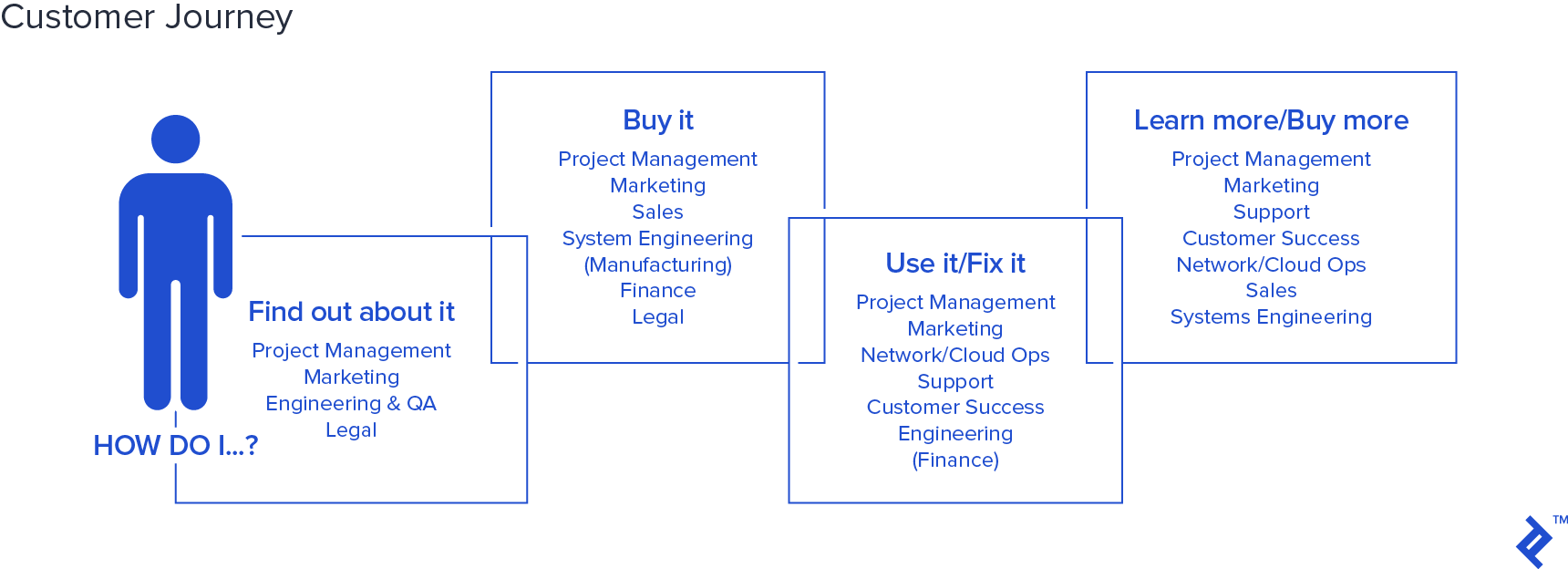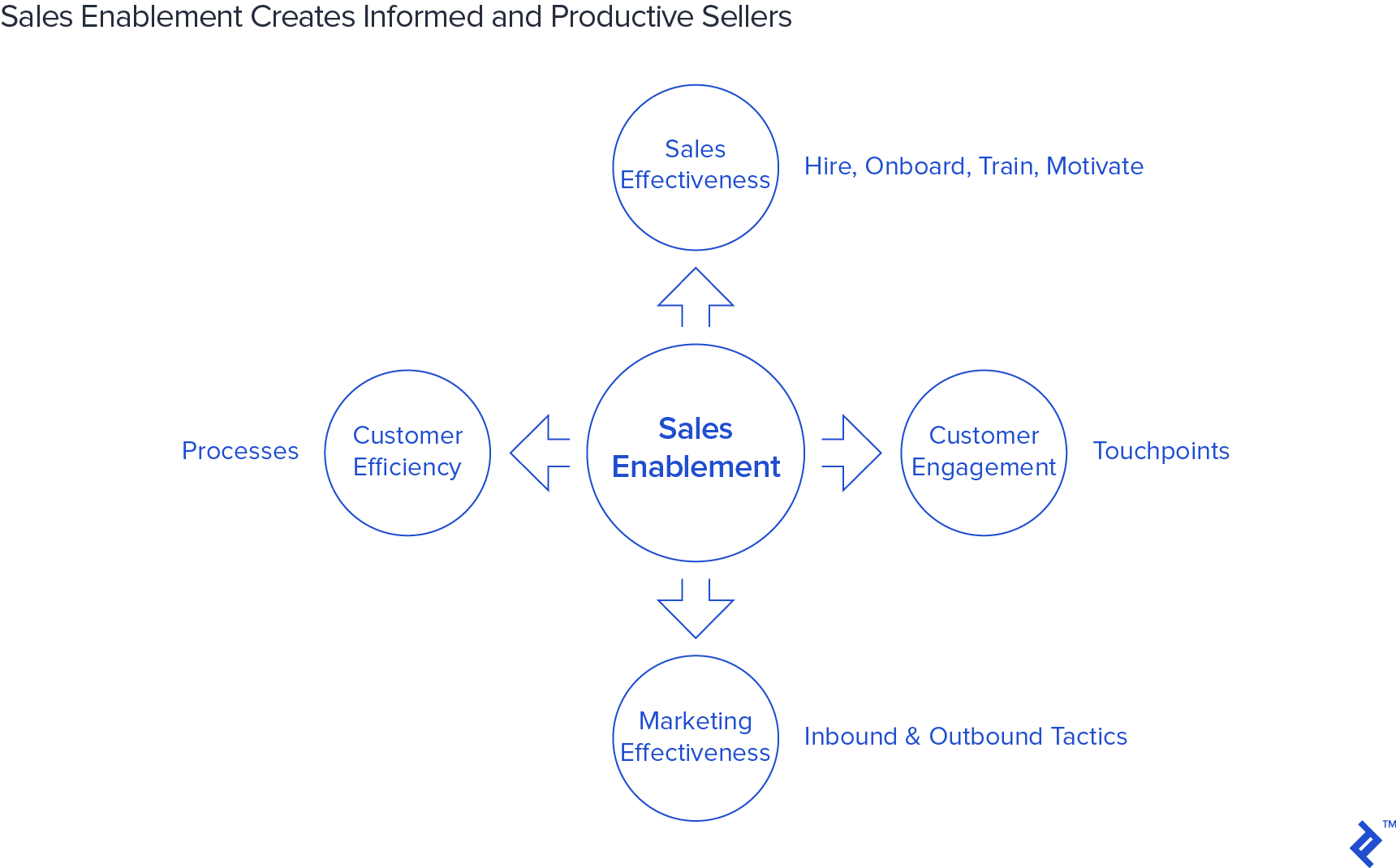Customer Journey Touch Points for Product Managers
Product management leaders will view every discussion, planning session, and milestone with the customer journey touch points in mind. A well-aligned corporate culture, emphasizing the customer at every interaction, will drive customer loyalty.
Product management leaders will view every discussion, planning session, and milestone with the customer journey touch points in mind. A well-aligned corporate culture, emphasizing the customer at every interaction, will drive customer loyalty.
Laurie is a leader with more than 20 years of experience skilled in turning ideas into unprecedented results.
Expertise
PREVIOUSLY AT

Introduction
This article looks at customer journey touch points from a product management (PdM) perspective. It assumes that the investment in the product/service has been approved and there is a business commitment to getting it to market. This is not an exhaustive list of all the checklist items that a PdM needs to consider, but rather an approach to support a successful customer-focused business.
A well-organized PdM will have a plan for coordinating with the entire organization as they plan their go-to-market strategy. They will look at the big picture and ask hard questions. Their skills in communicating, negotiating, and educating will be well exercised as they work with sister organizations to make sure their customers enjoy a stress-free, positive relationship with the company.
A PdM decision should always evaluate customer risk and reward. “Will a customer leave us if I don’t do this thing?” “Will I win more customers faster if I make this choice?” “Will our risks be mitigated if we prioritize this?” PdMs make decisions that provide the best outcome.
Refer to the product management customer journey touch points to tease out the detailed plan, create new approaches, get creative, and gain supporters. Walk through customer journey touch point examples by asking the “how” questions. Tease out the gaps to resolve them before they become escalations.
What Are Customer Journey Touch Points?
Customer journey touch points start from the very second that a potential customer hears about the product. The job, as an expert PdM, is to ensure that from that first second, the customer relationship creates a positive outcome.

When you think about a customer journey cycle, consider it a company’s smooth interactions with a potential customer as the measure of preparedness. Daily decisions concerning how to represent each product will be required, and it should be continuously reviewed for changes and exceptions.
Customers Need to Find Out About It
PdMs need to establish a framework for customers to find out about a solution. Some of the touch points below will help get this done.
Marketing
Marketing is a critical partner. Marketing turns vision into the values that customers are looking for. They will help move from talking about cool functions and features to describing how amazing technology has business value–changing the conversation from bits and bytes to dollars and cents.
Look to the marketing team for supporting the key go-to-market activities including website, collaterals, social platforms, launches, user groups, webinars, industry events, road shows, giveaways, advisory boards, branding, and naming. Work with marketing on sales enablement in preparation of a product launch. If the go-to-market approach leverages channels, then the channel programs need to be ramped up.

Sales enablement is a valuable investment of time for a PdM. The more informed a sales organization is, the more productive they will be. Invest time with marketing to ensure sales enablement is comprehensive. Test processes and procedures for how to take a prospect and turn them into a sale.
With a focus on lead generation, brand positioning, market positioning, and customer conversion, PdMs have the opportunity to help marketing position products for success and set the right expectations.
Project Management
The project management role varies in different business, but as a critical gatekeeper, the operational day-to-day business operations must be taken care of. Project management should coordinate with responsible owners to help drive the release process, including documentation, roadmaps, stock keeping units (SKUs), verifying the handling of order processing, supporting the deal desk, documenting pricing models, and supporting pricing exceptions. A strong project manager has the unique skill of identifying gaps before they become sinkholes.
Engineering and Quality Assurance
Aside from delivering a high-quality product to market, the PdM needs to consider the “what if” scenarios. Is the code protected; is it ensured for high availability and planned for disaster recovery? Is the data protected; is there a proper data management policy in place; are the best practices of security policies applied? Is the security appropriate, and does it meet regulatory requirements? If the solution includes elements from other vendors, what happens if that vendor fails? Is there a backup vendor?
During the early phases of the customer journey touch points, engineering may be asked to support a demo environment. As the relationship progresses, a proof of concept (PoC) or minimum viable product (MVP) may also be requested. Prepare the engineering team to work closely with customers to incorporate the appropriate decisions, get useful feedback and validate the quality and performance of the MVP.
Legal
PdMs must work with legal to protect the company at every juncture of the customer journey. Some areas to review include intellectual property rights (IPR) protections/patents, end-user license agreement (EULA) or subscription service agreements, copyrights, trademarks, brands, and names.
If there are third-party vendors that contribute to a solution, is there an escrow arrangement established? PdMs will want to coordinate with the deal desk/sales and legal to make sure that the customer and channel contracts are appropriately scoped to support the product and the business models.
Customers Need to Be Able to Buy It
When the company is starting to get the word out it’s time to examine and test the buying processes. “Time to close” and “time to revenues” are critical key performance indicators (KPIs) to consider and explore how you can improve. Onboarding (getting a customer to use a solution) may take more than just pricing it in a catalog on the website. Review and test the pricing models, the contracting models, the invoicing models, the provisioning methods and the training models.
Marketing
Marketing should be part of your team for the early adopter programs (EAPs), proof of concepts (POCs), and minimal viable product (MVP) programs with regular feedback and an open line of communications, rewards, and incentives.
It is during this phase that PdM and marketing are testing the messaging and evaluating the prospect’s responses to a product. Success at this stage is critical to generating qualified leads and building a sales funnel.
What needs to be in place to move a customer from a qualified prospect to a sale? Beyond sales enablement, what else is required? Some considerations that should be discussed may include App Store or online catalog integration, calls to action on the website, partner programs, market development funding (MDF) for partners, launch incentives, migration plans, polishing of customer-facing materials, and other functions that will simplify the sales closing functions.
Sales
Sales become involved at this stage as prospects become qualified prospects. In preparation for a sale, PdMs should walk through the sales process from that first interaction to delivery and onboarding. Identify any sales incentives, customer or sales promotions. Triple check that the sales team are ready and able, contracts available, channels (if appropriate) and routes-to-market understood.
It’s not unusual for a company to have a prioritized list of strategic accounts (sometimes referred to as a VIP or LightHouse account list). Align the product management efforts with the strategic account priorities to focus energies in the specific areas that align with the priorities of the sales organizations. On a weekly call, ask the question, “What can product management do to help you close this deal this week?” Commit and follow up to create a close relationship with the sales organization. Closing deals will be the foundation for success.
Systems Engineering
The Systems Engineering team are often a buffer for PdMs. They should be the direct interaction point with the technical teams from your customer. Ensure that they are ready with the training, processes, and tools to support demos, POCs, and MVPs.
In many organizations, the training organization may be associated with the systems engineering teams. Review that they are ready with the customer-facing training programs.
Manufacturing
PdMs must forecast carefully to ensure that the company can deliver against its orders when there are physical products involved. Early and constant communications, coordinating with sales and the systems engineering teams to predict volumes well ahead of time, is a critical success factor.
Finance/Operations
Work with your project managers to walk through the buying processes and “follow the money” in your product-customer journey analysis. Ensure that the order processing is linked in with the provisioning and software license enablement. What about the need for license keys? Are there downstream royalties that must be managed? What is the impact and action plan for payment delays, returns, replacements, upgrades? How are commissions handled? Does the software track the right metrics for financial reporting? How are bookings and revenues calculated?
With a solid understanding of the financial aspects, PdMs can make more effective decisions about pricing, competitive positioning, and deal management, while ensuring that the company is positioned for sales and growth.
Legal
Test out every customer contract negotiating scenario. Having these discussions with sales, deal desk and legal ahead of time will dramatically reduce the last-minute stress of contract negotiations when dealing with quarterly or annual deadlines. Ask what contract issues are going to be show-stoppers, and what are the negotiating tactics? Often these discussions will surround policies for service level agreements (SLAs), support, warranties or guarantees and liabilities.
Customers Need to Be Able to Use It – Fix It
The contract is signed. This is just a kickoff for gaining adoption. Successful products will be able to demonstrate growth in usage, creating ongoing value for a customer. Product managers must consider the reports and metrics that will provide continuous feedback to the customer and demonstrate that they’ve made a good investment.
There will be unhappy customers. Even if everyone has done everything perfectly, customers will want more, or maybe they did not have the right expectations. Discuss the planning and processes that need to be in place to ensure the offering(s) work, and that the reputation of the company is protected. Work with marketing and sales to set appropriate customer expectations at every step of the customer journey.
Marketing
The brand image of the company is core to the success of marketing. Work with the marketing organization to explore replacement / upsell programs, customer incentives, documenting and promoting customer wins (or recovery wins). Coordinate with them for analysts relations (AR) and public relations (PR). If market share and market positioning are part of your corporate goals, plan these in the go-to-market strategy.
Network/Cloud Operations
PdMs should talk through the key performance indicators (KPIs) that will drive your SLAs, manage and advertise uptime, report outages as required, and accelerate onboarding, upgrades, and migrations. Define if or how you will publicize outages while protecting your company brand.
Support
PdMs should coordinate with Support to be prepared and responsive in managing SLAs, help desk response times, working with the user community, and driving customer training. Support will be a high-value contributor to the new feature request (NFR) process and the backlog.
Customer Success
An emerging model for most long-term customer relationships – prevalent in subscription services, is the customer success program. Usually a billable service, this role encompasses driving adoption of the offering to extend the customer lifetime value (CLV). If “value” (more revenues, reduced costs, etc.) has been identified as part of the sales process, a customer success team should be able to track progress towards that value and catch any lack of progress before the customer churns. They will also be a key contributor to the NFR pool for future development.
Engineering
PdMs should review the support escalation processes with engineering to prioritize fixes, solve issues, and meet commitments and SLAs.
Customers for Life—Learn More, Buy More
It’s a common premise that it costs 6 times less to keep or grow an existing customer than to acquire a new customer. Explore how the different teams can extend the relationship with the customer to drive the CLV.
PdMs need to be thinking years ahead. Create short- and long-term roadmaps, and create a strong vision that your customers can share in. Always look for the appropriate pricing and business models and stay competitive, or, better yet, lead the market with innovative solutions that solve customer problems. Create a differentiable value.
Marketing
Marketing has a strong role in the CLV. Some common tactics for extending customer relationships include customer conferences, webinars, seminars, training, customer advisory boards, social networking blogs, customer communities, and awards. Managing the net promoter score (NPS) is a common gauge for customer satisfaction.
Support
Customers generally want to contribute/drive product direction. The Support organization can help with managing NFR inputs, monitor and self-heal against SLAs, and track and report “time to fix.”
Customer Success
The customer success team often has the strongest relationship with the customer. PdMs should partner closely with customer success in developing roadmaps, performing market research, and validating assumptions.
Network and Cloud Operations
Encourage marketing to work with the network and cloud operations teams to market strong results. Track volumes of customers, track volumes of transactions, track performance uptimes and promote the strength of the offerings.
PdMs should also coordinate with engineering and the network and cloud operations teams to manage gross margins. A goal of continuous improvement will help to drive profitability.
Sales
Whether it’s inside or outside sales, PdMs should constantly explore how to optimize revenues, sell more, sell faster, and upsell to more comprehensive solutions.
Systems Engineering
Bring systems engineering together with customer success to help drive the roadmap, increase usage of your product, effectively use more of the features, and help customers to buy more products.
Conclusion
There is no single approach to getting product management right. It is a unique role, bridging technology with the business needs of the customer. Everyone in the company has a role in supporting the positive relationship between the customer and the company. Product management needs to take a lead in discussing the customer journey touch points with each person in the company. Ask how they fit. Ask what they need from product management to make the customer journey a positive experience for each and every customer. You’ll be surprised at the support you get when you ask.
Further Reading on the Toptal Blog:
- Growth Product Management: What You Need to Know
- Product Management Empowered by the Entrepreneurial Mindset
- Learning to Learn: 5 Tips to Master Any Product Management Domain
- Customer Journey Maps: What They Are and How to Build One
- Getting Started in AI Product Management
- HiPPOs and the Product Roadmap: How to Manage Senior Stakeholder Intervention
- 5 Signs Your Product Strategy Is Broken—and How Designers Can Help Fix It
- Creating Success: A Guide to Product Manager KPIs
- 5 Common Mistakes in Requirements Gathering
Understanding the basics
What is meant by customer journey?
Customer journey references any point of time that a prospect or customer engages in learning about, reading, connecting to, or calling the company to achieve a purpose.
Why is reviewing the customer journey important?
Product Managers need to influence their entire company to understand why they are being asked to help. Putting decisions in the perspective of the customer journey touch points will help with understanding and commitment from the team.
What are some examples of customer journey touch points?
Customer journey touchpoints may include a help desk request, a purchase, a request for pricing, or request for proposal. In early stages, it may just be a search of the corporate website, looking for specific product information.
What is a customer journey map?
A customer journey map is a graphical representation of the points in time that a customer will interact with a system or a company. It will describe the inputs and outcomes of the “conversation.”
What are the four phases of a customer journey?
Phase 1 describes interactions with a prospect to find out about your product. Phase 2 will describe the conversion from prospect to customer touchpoints. Phase 3 will onboard the customer. Phase 4 will manage or upsell the customer.
Laurie Harvey
Port St. Lucie, FL, United States
Member since October 26, 2018
About the author
Laurie is a leader with more than 20 years of experience skilled in turning ideas into unprecedented results.
Expertise
PREVIOUSLY AT


